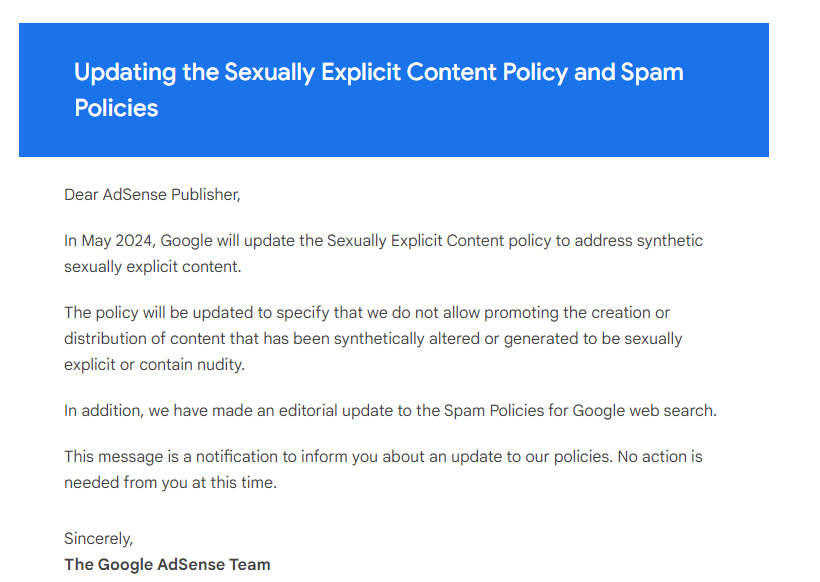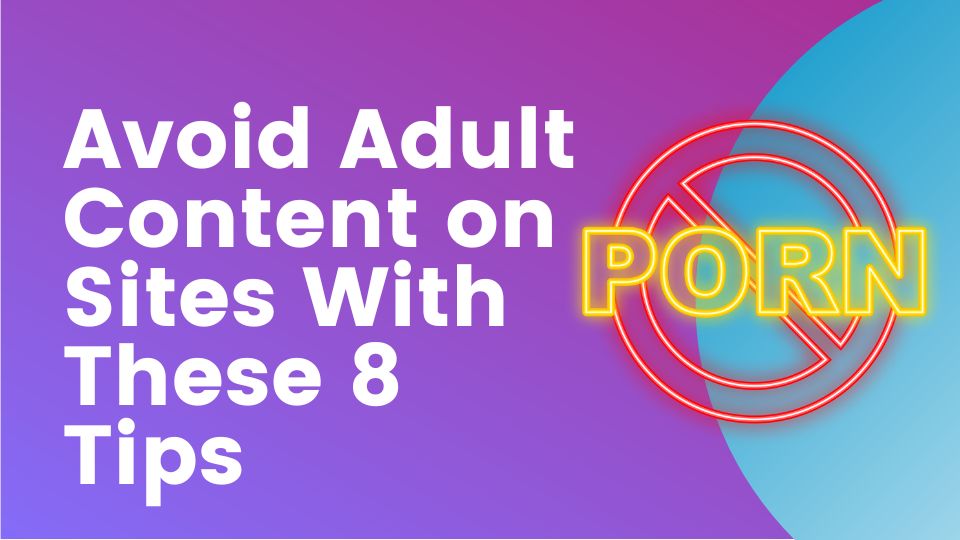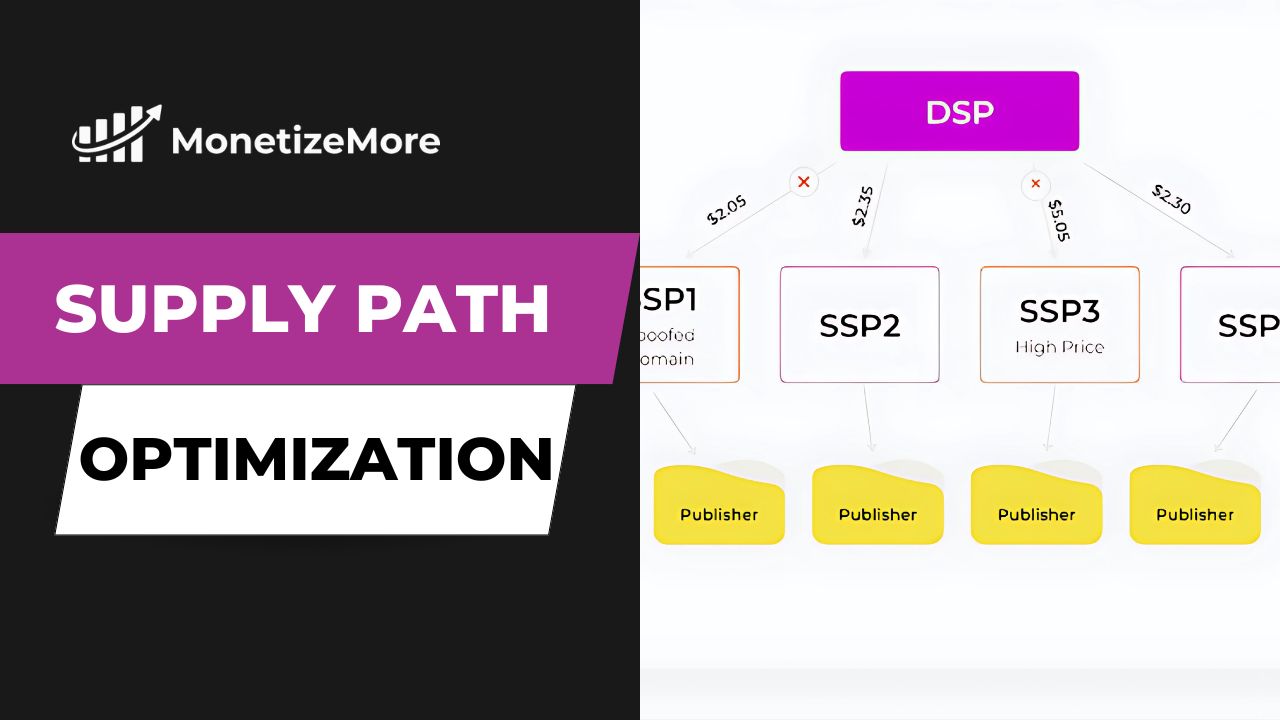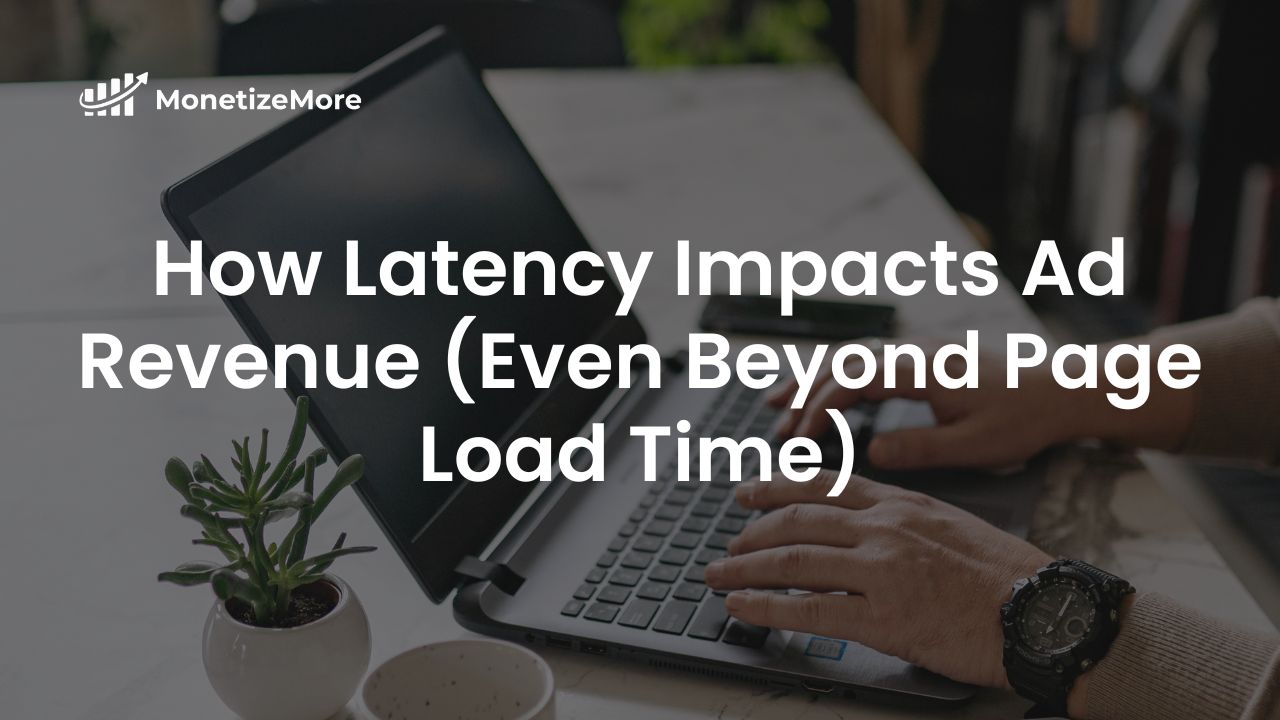In a significant move to maintain a safe and appropriate online environment, Google has announced an update to its Sexually Explicit Content policy, specifically targeting synthetic sexually explicit content. This update, set to take effect in May 2024, aims to prohibit the promotion of content that has been artificially altered or generated to depict sexually explicit material or nudity.
This article will also provide you with expert insights on how to steer clear of adult content and ensure your website aligns with Google Ads guidelines, ultimately boosting your ad revenue potential.
What is inappropriate content?
“Inappropriate” can be tricky to define because it is an inherently subjective term. One person’s classy art might be another person’s pornography. However, Google has tried to define “inappropriate” as objectively as possible. If your site’s content fits any of these parameters, then you’re in violation of Google’s terms and need to rectify the situation:
- Full frontal nudity.
- Strategically covered nudity.
- Content or text intended to be sexually stimulating.
- Adult language, even in comment sections or message boards.
- Content about illegal drugs.
Understanding Synthetic Sexually Explicit Content

Synthetic sexually explicit content refers to digital media, including images, videos, or animations, that portray sexual content or acts but are not captured from real-life scenarios. Instead, these materials are created or manipulated using artificial intelligence (AI) or computer graphics technologies.
By leveraging AI algorithms, deep learning methods, or computer-generated imagery (CGI), creators can produce lifelike representations of sexual content or individuals engaging in sexual activities without the involvement of real individuals or events. This type of content raises concerns regarding authenticity, consent, and the potential for misuse or exploitation. By updating its policy to disallow the promotion of synthetic sexually explicit content explicitly, Google is taking a proactive stance to prevent the dissemination of misleading or harmful material.
Impact of the Policy Update
With this policy update, Google aims to create a safer online environment by restricting the proliferation of synthetic sexually explicit content. By prohibiting the promotion of such content, Google seeks to uphold community guidelines, protect users from potentially harmful or misleading material, and maintain the integrity of its platforms.
Content creators, publishers, and advertisers are encouraged to review and adhere to these updated policies to ensure compliance with Google’s guidelines. Failure to comply with these regulations may result in content removal, account suspension, or other enforcement actions as outlined in Google’s policies.
The key points on the impact of Google’s policy update on synthetic sexually explicit content are:
- Creating a Safer Online Environment: By restricting the promotion of synthetic sexually explicit content, Google aims to foster a safer and more trustworthy online environment for its users. This policy update is a proactive measure to address the challenges posed by the increasing prevalence of artificially generated or manipulated sexual content.
- Upholding Community Guidelines: The policy update aligns with Google’s commitment to upholding its community guidelines and maintaining the integrity of its platforms. By prohibiting the promotion of synthetic sexually explicit content, Google is reinforcing its stance against the dissemination of misleading or potentially harmful material.
- Protecting Users: The policy change is intended to protect users from exposure to synthetic sexually explicit content, which can be misleading, exploitative, or psychologically damaging, especially for vulnerable individuals. By restricting such content, Google aims to safeguard its user base from potential harm.
- Compliance for Content Creators, Publishers, and Advertisers: The updated policy requires content creators, publishers, and advertisers to review and adhere to the new guidelines. Failure to comply may result in consequences such as content removal, account suspension, or other enforcement actions outlined in Google’s policies. This underscores the importance of these stakeholders staying informed and aligned with policy changes.
- Maintaining Platform Integrity: By addressing synthetic sexually explicit content, Google is taking steps to maintain the overall integrity and trustworthiness of its platforms. This policy update is part of Google’s broader efforts to ensure a safe, authentic, and high-quality online environment for its users.
The Previous No-Adult Content Policy

The last No-Adult Content policy wasn’t just an arbitrary one Google instated to make life more difficult for web publishers. There are real and valid reasons why this policy is written into Google’s terms, and they have to do with Google’s revenues — present and future.
Advertisers wouldn’t buy as many ads if they knew their ads were going to be on adult websites. In a way, Google’s strict and rigid rule protects your future ad revenue. It might be frustrating to make your site compliant with Google’s adult content restrictions — particularly if your site is in the gray area between appropriate and inappropriate — but it’s for the best in the long run.
Google’s policies regarding adult content were focused on maintaining a family-safe and advertiser-friendly environment. Here are some general guidelines that were in place:
- Prohibited Content: Google Ads prohibits the promotion of explicit adult content, including pornography, sexually explicit material, and adult-oriented products or services.
- Nudity and Sexual Content: Displaying explicit nudity or sexual content, whether visual or textual, is typically not allowed. This includes images or text that depict explicit sexual acts, genitalia, or excessive focus on sexual body parts.
- Adult-oriented Products and Services: The promotion of adult-oriented products such as sex toys, adult dating or escort services, and adult video content is generally not allowed.
- Age-Restricted Content: Publishers should comply with applicable laws and regulations regarding the display of age-restricted content. Advertisements for products or services intended for adult audiences should be appropriately targeted and labeled to prevent exposure to underage users.
Understanding the Importance of Avoiding Adult Content
To avoid adult content, publishers must adhere to Google Ads policies, protect their ad revenue, preserve user trust, maintain a positive brand reputation, comply with legal regulations, create a positive user environment, and expand their advertising opportunities. In this section, we will explore the reasons why publishers should prioritize keeping their sites free from adult content.
- Adherence to Google Ads Policies: Google Ads has strict guidelines regarding adult content, and violating these policies can result in severe consequences such as ad restrictions, account suspension, or even permanent removal from the platform. By avoiding adult content, publishers can ensure compliance with Google’s policies and maintain a positive relationship with the platform.
- Protecting Ad Revenue: Displaying adult content on a website can significantly impact ad revenue potential. Advertisers often prefer to showcase their ads on websites that offer a safe and family-friendly environment. By avoiding adult content, publishers increase the likelihood of attracting a wider range of advertisers and maximizing their revenue potential.
- Preserving User Trust and Experience: Users visit websites with certain expectations, and encountering adult content on a site that doesn’t align with their preferences can lead to a negative user experience. By steering clear of adult content, publishers can maintain the trust of their audience and provide a positive browsing experience, resulting in longer engagement and potential repeat visits.
- Safeguarding Brand Reputation: Advertisers are cautious about associating their brands with websites that display adult content. Publishing explicit material can tarnish a publisher’s reputation and deter reputable advertisers from partnering with them. By avoiding adult content, publishers can safeguard their brand reputation and attract advertisers who prioritize a clean and safe online environment.
- Compliance with Legal Regulations: In addition to Google’s policies, publishers must also consider legal regulations concerning adult content. Displaying explicit material without proper age restrictions or compliance can lead to legal repercussions. By steering clear from adult content, publishers can ensure compliance with applicable laws and regulations, minimizing the risk of legal issues.
- Creating a Positive User Environment: For many websites, fostering a positive user environment is a priority. By avoiding adult content, publishers can cultivate a welcoming, inclusive space suitable for users of all ages and backgrounds. This attracts a broader audience, encourages user engagement, and promotes a sense of community.
- Expanding Advertising Opportunities: Some advertisers have strict guidelines that restrict them from displaying ads on websites with adult content. By maintaining a website free from such content, publishers open doors to a wider range of advertising opportunities, increasing the chances of securing lucrative partnerships and diversifying their revenue streams.
Conducting Thorough Content Audits

Regular content audits are crucial to ensure your website remains free from adult content. It involves systematically reviewing all aspects of your website’s content to identify and remove any explicit or inappropriate material. Here’s a checklist of the content audit process in points:
- Develop Content Guidelines: Establish clear and comprehensive content guidelines that explicitly state what is considered acceptable and unacceptable content on your website. These guidelines should align with your target audience, industry standards, and Google Ads policies.
- Categorize Content Types: Identify and categorize the various types of content on your website, such as text, images, videos, user-generated content, comments, and advertisements. This will help streamline the auditing process and ensure all content areas are covered.
- Automated Content Analysis Tools: Utilize automated content analysis tools to scan your website for potentially explicit or adult content. These tools use algorithms and machine learning to detect inappropriate language, imagery, or keywords that may indicate adult content. Some popular tools include Google SafeSearch, Microsoft Content Moderator, and third-party moderation services.
- Manual Review Process: Conduct manual reviews of your website’s content to ensure accuracy and address any content that may have been missed by automated tools. This involves going through each page and scrutinizing the text, images, and other media for potential adult content. Pay attention to captions, alt tags, metadata, and user-generated content as well.
- User-Generated Content Moderation: If your website allows user-generated content, implement a robust moderation system to review and approve user submissions before they appear on your site. This includes comments, reviews, forum posts, or any other form of content that users can contribute. Establish clear guidelines for user-generated content and empower your moderation team to enforce them effectively.
- Regular Updates: Conduct content audits on a regular basis to ensure ongoing compliance with content guidelines and policies. Set a schedule for audits, considering factors such as website growth, content updates, and industry standards or regulations changes.
- Documentation and Tracking: Maintain a record of the content audit process, including the date of each audit, the findings, and the actions taken to address any issues. This documentation serves as evidence of your commitment to maintaining a clean and ad-friendly website.
By conducting thorough content audits, publishers can maintain a safe and ad-friendly environment for their audience.
Implementing Robust Filtering and Moderation Systems
As a publisher, implementing robust filtering and moderation systems can help prevent adult content from appearing on your website. Here are some steps to guide you in achieving this:
- Define Clear Content Guidelines: Establish clear and comprehensive content guidelines that explicitly state what is considered acceptable and unacceptable content on your website. This will serve as a foundation for your filtering and moderation systems.
- Utilize Profanity Filters: Implement profanity filters that automatically detect and flag or block inappropriate language. Profanity filters can help catch explicit content or offensive language that may be used in user-generated content, comments, or other text fields on your website.
- Image Recognition Technology: Consider automatically using image recognition technology to automatically analyze and identify explicit or adult-oriented images. These tools can scan images uploaded to your site and flag or block those that violate your content guidelines.
- User-Generated Content Moderation: If your website allows user-generated content, establish a moderation system to review and approve user submissions before they are published. Assign a dedicated team or employ moderators to actively monitor and filter out any adult content or inappropriate material. Provide them with clear guidelines and instructions on effectively enforcing the content standards.
- Report and Flagging Mechanisms: Encourage your users to report any content that violates your guidelines. Implement a user-friendly reporting system that allows visitors to flag inappropriate content easily. Actively review and take action on reported content to ensure a clean and safe user experience.
- Manual Review and Approval: Establish a manual review and approval process for content requiring human evaluation, such as advertisements or sponsored posts. Assign qualified individuals or a team to assess and vet content before it is published on your website.
- Regular Audits and Updates: Conduct regular content audits to ensure ongoing compliance with your content guidelines. Review and update your filtering and moderation systems as needed to stay ahead of evolving content challenges and enhance your filters’ accuracy and effectiveness.
- Stay Informed: Stay updated on industry trends, best practices, and changes in policies related to adult content. Regularly review the guidelines and recommendations provided by platforms like Google Ads to align your filtering and moderation systems with their policies.
These systems help maintain a safe and ad-friendly environment, ensuring a positive user experience and attracting reputable advertisers.
Monitor your users
One of the ways in which sites sometimes run afoul of these guidelines is in user-generated content. Did you know that user-generated content, like comments and forum posts, can put you in violation of these guidelines?
That means that it’s absolutely imperative to monitor the content your users post on your site. It would be a shame to be rejected by Google AdSense or Ad Exchange just because some of your users posted inappropriate material on your site. And remember: you’re even on the hook if you link to inappropriate content; it doesn’t have to be posted directly on your site.
If you get a flag for one of these violations, it probably won’t mean you will get kicked off of Google’s ad products permanently. Just rectify the error and reapply.
You don’t have to make your site kid-friendly to get accepted to Google’s ad products, but you should at least rid your site of material you wouldn’t repeat or show others in polite company. If you still need extra clarification about whether your site is compliant with Google’s terms and conditions, watch the aforelinked video or review Google’s terms and conditions. Those two resources alone should give you a good sense of whether your site is compliant. When in doubt, use common sense!
Conclusion
Google’s update to its Sexually Explicit Content policy to address synthetic sexually explicit content reflects its commitment to fostering a secure and respectful online ecosystem. By setting clear guidelines and restrictions on the promotion of artificially generated sexual content, Google aims to safeguard users, uphold community standards, and promote responsible online behavior.
Content creators and publishers should stay informed about these policy changes and ensure that their content aligns with Google’s updated guidelines to maintain a positive online presence and contribute to a safer digital environment.
Are you struggling with content policies and taking your AdSense income to the next level? You can try out our free No More AdSense Bans course here!
With over ten years at the forefront of programmatic advertising, Aleesha Jacob is a renowned Ad-Tech expert, blending innovative strategies with cutting-edge technology. Her insights have reshaped programmatic advertising, leading to groundbreaking campaigns and 10X ROI increases for publishers and global brands. She believes in setting new standards in dynamic ad targeting and optimization.







